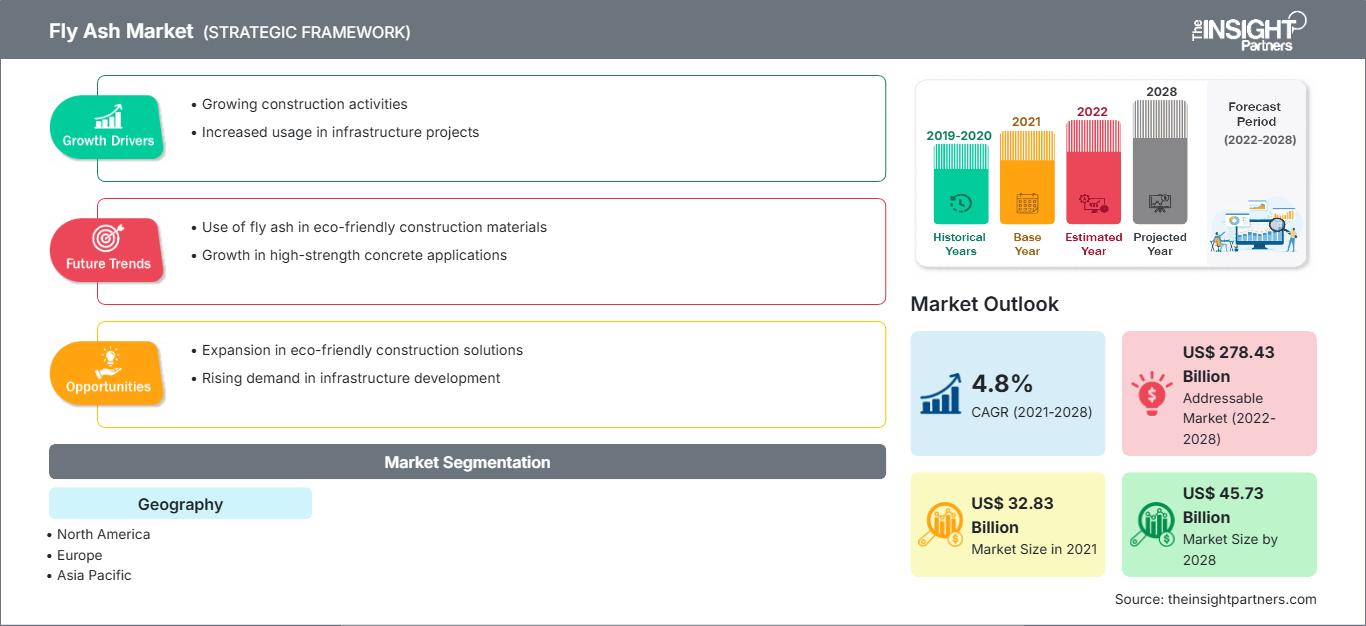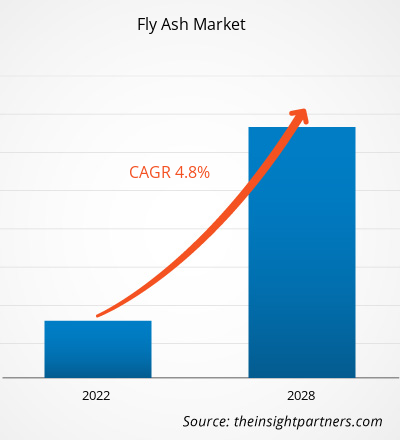[Informe de investigación] El mercado de cenizas volantes se valoró en 32.830 millones de dólares estadounidenses en 2021 y se prevé que alcance los 45.730 millones de dólares estadounidenses en 2028; se espera que crezca a una tasa de crecimiento anual compuesta (TCAC) del 4,8% entre 2021 y 2028.
ANÁLISIS DE MERCADO
La ceniza volante se produce como residuo de la combustión y contiene partículas finas como dióxido de silicio, óxido de aluminio, óxido férrico y, en ocasiones, óxido de calcio. Es un polvo fino de color gris con propiedades puzolánicas que reacciona con la cal para formar compuestos de cemento. Se utiliza en una amplia gama de aplicaciones, como la mezcla de cemento y hormigón, minas y presas, vertederos y hormigón geopolimérico, entre otras. Mejora el rendimiento del hormigón durante la mezcla y actúa como catalizador para la conversión del polietileno durante la pirólisis.
FACTORES DE CRECIMIENTO Y DESAFÍOS
El crecimiento constante del sector de la construcción está impulsando significativamente el crecimiento del mercado mundial de cenizas volantes. Los países de Asia Pacífico, como Estados Unidos, China e India, concentran la mayor actividad constructiva del mundo. El elevado ritmo de la construcción genera una enorme demanda de diversos materiales. Las cenizas volantes se utilizan en múltiples aplicaciones específicas de la construcción, como cemento, hormigón, ladrillos y bloques. Su uso está en aumento para una variedad de aplicaciones en el sector. Además, este creciente uso está impulsando aún más el crecimiento del mercado mundial de cenizas volantes. Las cenizas volantes se utilizan en diversas aplicaciones, como cemento y hormigón, bloques y ladrillos, minería, rellenos y terraplenes, entre otras. Debido a sus propiedades puzolánicas, el uso de cenizas volantes en el hormigón es muy beneficioso, ya que mejora su durabilidad. En la fabricación de hormigón de cemento Portland, las cenizas volantes se utilizan como material cementante suplementario (MCS) para mejorar el rendimiento de este hormigón. Los ladrillos de cenizas volantes se utilizan como material de construcción en lugar de los ladrillos de arcilla. En comparación con los ladrillos de arcilla tradicionales, los ladrillos de ceniza volante son más ligeros y resistentes, económicos, no requieren enlucido y pueden contribuir a reducir los gastos de construcción y la erosión del suelo. Sin embargo, el desconocimiento de los beneficios y posibles usos de la ceniza volante podría limitar su crecimiento en el mercado. La ceniza volante es una materia prima importante para diversas aplicaciones. No obstante, existe un desconocimiento de la química de la ceniza volante y sus derivados para su uso en aplicaciones finales adecuadas. Esta falta de información pública sobre los productos es una de las causas de su baja utilización.
Obtendrá personalización gratuita de cualquier informe, incluyendo partes de este informe, análisis a nivel de país y paquetes de datos de Excel. Además, podrá aprovechar excelentes ofertas y descuentos para empresas emergentes y universidades.
Mercado de cenizas volantes: Perspectivas estratégicas

- Obtenga las principales tendencias clave del mercado que se describen en este informe.Esta muestra GRATUITA incluirá análisis de datos, que abarcarán desde tendencias de mercado hasta estimaciones y pronósticos.
SEGMENTACIÓN Y ALCANCE DEL INFORME
El informe "Análisis del mercado mundial de cenizas volantes hasta 2030" es un estudio especializado y exhaustivo que se centra en las tendencias y oportunidades de crecimiento del mercado mundial de cenizas volantes. El informe ofrece una visión general del mercado mundial de cenizas volantes, con una segmentación detallada por tipo, aplicación y geografía. El mercado mundial de cenizas volantes ha experimentado un fuerte crecimiento en los últimos años y se prevé que esta tendencia continúe durante el período de pronóstico. El informe proporciona estadísticas clave sobre el consumo mundial de cenizas volantes, así como su demanda en las principales regiones y países. Además, ofrece una evaluación cualitativa de los diversos factores que afectan al rendimiento del mercado de cenizas volantes en las principales regiones y países. El informe también incluye un análisis exhaustivo de los principales actores del mercado de cenizas volantes y sus principales desarrollos estratégicos. Asimismo, se incluyen varios análisis sobre la dinámica del mercado para ayudar a identificar los principales factores impulsores, las tendencias del mercado y las oportunidades lucrativas del mercado de cenizas volantes, lo que, a su vez, contribuirá a identificar las principales fuentes de ingresos.
Además, el análisis del ecosistema y el análisis de las cinco fuerzas de Porter proporcionan una visión de 360 grados del mercado mundial de cenizas volantes, lo que ayuda a comprender toda la cadena de suministro y los diversos factores que afectan al crecimiento del mercado.
ANÁLISIS SEGMENTAL
El mercado mundial de cenizas volantes se segmenta según su tipo y aplicación. Por tipo, se divide en cenizas tipo C y tipo F. Por aplicación, se clasifica en cemento y hormigón, bloques y ladrillos, minería, estabilización de carreteras, rellenos y terraplenes, estabilización de residuos y otros. El segmento de cenizas tipo C representó la mayor parte del mercado, debido al creciente uso de este material en diversas aplicaciones. Las cenizas volantes tipo C se obtienen frecuentemente de carbón subbituminoso y lignito. Sus propiedades de autoendurecimiento se deben a su alta concentración de cal viva (CaO). Son ideales para mezclas de alto rendimiento, aplicaciones de pretensado y otras que requieren mayor resistencia inicial. Gracias a su alto contenido de cal, son muy eficaces para la estabilización de suelos. Según su aplicación, el segmento del cemento y el hormigón representó una parte importante del mercado de cenizas volantes, lo que se atribuye a su creciente adopción en el sector de la construcción. Las cenizas volantes se utilizan como material cementante suplementario (MCS) para la fabricación de hormigón de cemento Portland. En comparación con el hormigón de cemento Portland de la misma trabajabilidad, el uso de cenizas volantes de excelente calidad, con alta finura y bajo contenido de carbono, reduce la demanda de agua del hormigón. Por consiguiente, las cenizas volantes permiten producir hormigón con un menor contenido de agua, lo que a su vez genera nuevas oportunidades de crecimiento para el sector en general.
ANÁLISIS REGIONAL
El informe ofrece una visión general detallada del mercado mundial de cenizas volantes en cinco regiones principales: Norteamérica, Europa, Asia-Pacífico (APAC), Oriente Medio y África (MEA) y Sudamérica y Centroamérica. Oriente Medio y África representaron una parte significativa del mercado, con un valor superior a los 600 millones de dólares estadounidenses en 2022 y una estimación de aproximadamente 1.000 millones de dólares estadounidenses en 2030. El rápido aumento de la actividad de la construcción, especialmente en Oriente Medio, contribuyó positivamente al crecimiento del mercado en esta región. Se prevé que Asia-Pacífico también experimente un crecimiento considerable, con un valor superior a los 25.000 millones de dólares estadounidenses en 2022, debido al creciente uso de cenizas volantes en diversas aplicaciones en la región, lo que impulsa el crecimiento del mercado mundial de cenizas volantes. Asimismo, se espera que Norteamérica experimente un crecimiento considerable, con un valor superior a los 4.000 millones de dólares estadounidenses en 2022, debido al mayor uso de cenizas volantes en la industria de la construcción, lo que se espera que impulse el crecimiento del mercado mundial de cenizas volantes.
DESARROLLOS DE LA INDUSTRIA Y OPORTUNIDADES FUTURAS
Se constató que las alianzas, las adquisiciones y los lanzamientos de nuevos productos eran las principales estrategias adoptadas por los actores que operan en el mercado mundial de cenizas volantes.
- En noviembre de 2021, LafargeHolcim en EE. UU., Geocycle y CenterPoint Energy se unieron para reciclar cenizas de carbón de centrales eléctricas procedentes de vertederos para su uso en la fabricación de cemento.
- En septiembre de 2021, Charah Solutions se adjudicó un contrato de 5 años para la venta y comercialización de cenizas volantes para el uso beneficioso de las cenizas volantes de producción en la central eléctrica de Gavin en Ohio.
IMPACTO DEL COVID/IMPACTO DEL ESCENARIO GEOPOLÍTICO/IMPACTO DE LA RECESIÓN
La pandemia de COVID-19 provocó una desaceleración en el progreso de numerosas industrias a nivel mundial. El cierre de plantas de fabricación y las restricciones comerciales globales generaron limitaciones en las cadenas de suministro para los fabricantes de todo el mundo. La pandemia actual ha alterado drásticamente la situación del sector químico y de materiales, impactando negativamente el crecimiento del mercado de cenizas volantes. La implementación de medidas para combatir la propagación del virus ha agravado la situación y afectado el crecimiento de varios sectores industriales. Muchas centrales térmicas no estuvieron operativas o funcionaron a menor capacidad, lo que impactó negativamente la generación y utilización de cenizas volantes. La pandemia ha creado una crisis sanitaria mundial que ha afectado a todas las industrias, incluyendo la construcción. La reducción de la actividad económica ha resultado en una menor demanda de nuevas instalaciones comerciales e industriales. La pérdida de ingresos y la falta de confianza del consumidor han afectado negativamente la demanda de construcción de viviendas. Asimismo, las obras de construcción han enfrentado interrupciones en las cadenas de suministro y restricciones operativas. Sin embargo, a medida que las economías planean reactivar sus operaciones, se espera que la demanda de cenizas volantes aumente a nivel mundial. Por lo tanto, el mercado de cenizas volantes se ha recuperado bastante bien de las secuelas de la pandemia y se espera que crezca en los próximos años.
Perspectivas regionales del mercado de cenizas volantes
Los analistas de The Insight Partners han explicado en detalle las tendencias regionales y los factores que influyen en el mercado de cenizas volantes durante el período de previsión. Esta sección también analiza los segmentos del mercado de cenizas volantes y su distribución geográfica en Norteamérica, Europa, Asia Pacífico, Oriente Medio y África, y Sudamérica y Centroamérica.
Alcance del informe de mercado de cenizas volantes
| Atributo del informe | Detalles |
|---|---|
| Tamaño del mercado en 2021 | 32.830 millones de dólares estadounidenses |
| Tamaño del mercado para 2028 | 45.730 millones de dólares estadounidenses |
| Tasa de crecimiento anual compuesto global (2021 - 2028) | 4,8% |
| Datos históricos | 2019-2020 |
| período de previsión | 2022-2028 |
| Regiones y países cubiertos | América del norte
|
| Líderes del mercado y perfiles de empresas clave |
|
Densidad de los participantes en el mercado de cenizas volantes: comprensión de su impacto en la dinámica empresarial
El mercado de cenizas volantes está creciendo rápidamente, impulsado por la creciente demanda de los usuarios finales debido a factores como la evolución de las preferencias de los consumidores, los avances tecnológicos y una mayor conciencia de los beneficios del producto. A medida que aumenta la demanda, las empresas amplían su oferta, innovan para satisfacer las necesidades de los consumidores y aprovechan las nuevas tendencias, lo que impulsa aún más el crecimiento del mercado.

- Obtenga una visión general de los principales actores del mercado de cenizas volantes.
PANORAMA COMPETITIVO Y EMPRESAS CLAVE
Algunos de los principales actores que operan en el mercado de cenizas volantes incluyen, entre otros, Boral LTD., Cemex SAB DE CV, Lafargeholcim Ltd., Waste Management, Inc., Charah, LLC, Separation Technologies LLC, Cement Australia PTY Limited, Salt River Materials Group, Ashtech India Pvt. Ltd. y Duromar, Inc.
- Análisis histórico (2 años), año base, pronóstico (7 años) con CAGR
- Análisis PEST y FODA
- Tamaño del mercado, valor/volumen: global, regional y nacional
- Industria y panorama competitivo
- Conjunto de datos de Excel
Informes recientes
Testimonios
Razón para comprar
- Toma de decisiones informada
- Comprensión de la dinámica del mercado
- Análisis competitivo
- Información sobre clientes
- Pronósticos del mercado
- Mitigación de riesgos
- Planificación estratégica
- Justificación de la inversión
- Identificación de mercados emergentes
- Mejora de las estrategias de marketing
- Impulso de la eficiencia operativa
- Alineación con las tendencias regulatorias






















 Obtenga una muestra gratuita para - Mercado de cenizas volantes
Obtenga una muestra gratuita para - Mercado de cenizas volantes